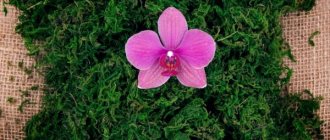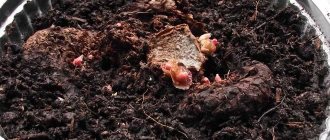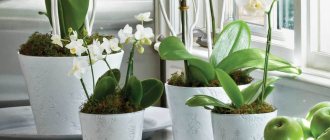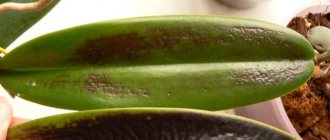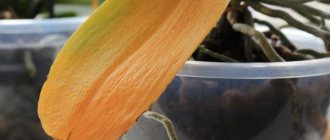Orchids most often like to grow on tree trunks, rocks and places where soil is present in small quantities. Only some types of orchids thrive on the soil. Because of this, pots for home orchids look different than standard flower containers.
What aspects should flower lovers consider when purchasing habitat for their plants? Which pot is suitable? This will be discussed in this article.
Here are modern coffee and coffee tables for the living room
What kind of pot is needed for an orchid?
Before deciding which pot to plant an orchid in, you should understand that the main task is to bring the conditions for growing a flower in an apartment as close as possible to natural conditions. The container performs a supporting function; it supports and guides the growth of the flower. The roots of the plant stick to the substrate and the walls of the pot, just like trees in nature. In addition, the container and substrate protect the plant roots from drying out.
Blooming orchids
Basic requirements for containers
When choosing dishes for keeping an orchid, each gardener chooses his own approach. Some prefer to grow the plant on blocks or in a closed system, while others choose a pot.
When choosing a suitable vessel for an orchid, you should pay attention to the following criteria:
- The container must contain a sufficient number of drainage holes so that the roots of the epiphytes can breathe freely.
- The transparent material of the pot is more important for ease of care, as it allows you to control the dosage of watering, monitor the condition of the roots and the phase of development of the plant.
- Orchid loves containers that fit the size of the root system. If the roots of the plant are healthy, then when replanting, take a larger container with room for growth. Sick flowers with damaged roots need a back-to-back pot, since a large amount of substrate will lead to stagnation of moisture and rotting of the roots.
- Which pot to choose depends on the type of plant. Phalaenopsis prefer transparent containers; for vande, it is better to choose glass; for epiphytes with pseudobulbs, ordinary ceramic containers are suitable.
Advice! To create additional aeration of the roots, you can make holes in the bottom and sides of plastic pots using a hot rod, soldering iron or drill.
Variety of orchid pots
Humidity and temperature in and around the pot
Epiphytes cannot tolerate waterlogging of the root system. Therefore, when choosing a container for a flower, you need to make sure that there are drainage holes on the bottom and bottom of the container. If there are no such holes, you should carefully monitor the humidity of the substrate. Stagnation of moisture can lead to mold on the roots of the orchid and its death.
In the absence of air circulation at the root system, the upper shell of the roots begins to rot and the plant does not receive the required amount of moisture and microelements.
Advice! If air circulation is insufficient, then a small fan can be installed near the flower.
The correct temperature is maintained thanks to the material from which the pot is made. It should not contribute to overheating or hypothermia of the root system.
Some orchid containers are equipped with an automatic watering system, which allows you to control the humidity of the plant substrate. This self-watering system is suitable when you cannot devote a lot of time to the plant, for example during vacation or a business trip.
Transparent plastic pots
Most orchids go on sale in plastic transparent pots for transportation. This container has several advantages:
- This is a budget option and it is easy for the seller to monitor the watering of the plant through the transparent walls;
- the roots of epiphytes practically do not stick to the plastic and, if desired, it can be easily removed for propagation or replanting;
- The root system of most orchids synthesizes light in the same way as the leaf of the plant, so transparent containers will ensure access of light rays to the roots.
Soil for dracaena - which one is needed and how to choose
The advantage of plastic containers is that you can make additional holes in them along the walls or bottom of the container yourself. This is perfect for a flower. The disadvantage of such a vessel is that it is very light and unstable. To avoid the plant tipping over, it is enough to choose a stable pot for orchids.
Advice! A plastic pot with a drainage system on the bottom and sides is the ideal way to grow phalaenopsis.
In addition to ordinary white plastic pots, in a flower shop you can choose a plastic flowerpot that will suit the interior of your home or office, of any size or color; it can be either transparent or matte.
Orchid in a transparent plastic pot
Features of caring for plants in such containers
- Watering rules must be strictly followed. Water the plant only on top of the soil using a watering can, then be sure to drain the excess water by turning the pot over and holding the root system.
- Watering should occur less often than in a standard pot with holes. The soil here will remain moist longer. It is recommended to water the flower once every 14 days, and it is easy to see the state of the substrate through the transparent walls.
- The top quick-drying layer of soil can be irrigated with a spray bottle.
- At the stage of active growth, add fertilizing with mineral fertilizers to the water for irrigation, but this must be done less often than in a regular container with holes.
- The substrate in a glass pot without drainage holes quickly becomes unsuitable for the plant, since it remains moist longer. Therefore, you need to replant an orchid in such a container at least once every two years.
Alternatively, you can drill holes in the bottom of the pot. It may not be as aesthetically pleasing, but it will be much easier for the plant.
When such an exquisite and unique flower as an orchid appears in the house, you want the accessories to match its status. Growing and preserving a delicate plant in a beautiful glass vessel is difficult, but possible if desired.
Clay and ceramic pots
Substrate for orchids - which one is best for growing?
Compared to plastic containers, these types are more stable and aesthetically pleasing. The porous structure of the material provides the necessary moisture and air exchange to the root system, but at the same time it is the reason for the development of flower diseases. Over time, the roots stick to the surface of the pot and, if you want to replant the plant, they are injured, which leads to damage to the orchid. Also, during watering, moisture evaporates through the pores and leaves salts on the walls, which are harmful to the health of the plant.
For reference! In a flower shop you can find two types of ceramic containers intended for epiphytes. They can be glazed or unglazed.
To safely care for the plant, it is better to choose earthenware with a glazed inner surface, then the roots will not be able to grow to the surface.
When choosing glazed dishes that look attractive, do not forget about the presence of a drainage system, without which the plant will not survive for long. An important point when choosing a ceramic flowerpot is the shade of the container itself. The best option would be light-colored dishes - this will help protect the plant from overheating its roots in the summer at elevated air temperatures.
Ceramic pots for orchids
Flowerpots made of ceramics or clay are more suitable for terrestrial varieties of orchids. Having bought just such a pot, the plant will feel as close as possible to its natural habitat.
Glass pots
In glass flowerpots, orchids look quite aesthetically pleasing. Such containers are quite practical in terms of benefits for the plant’s root system, as they provide a good amount of light to the roots.
How to replant Kalanchoe - what soil and pot are needed
But among flower growers, opinions on the use of this particular material for growing plants are divided. On the one hand, this method helps to retain moisture in conditions of low environmental humidity, but on the other hand, a closed container without drainage is a bad option for the plant.
Due to the accumulation of condensation on the walls of the flowerpot, green algae develops on the roots of the orchid. Replacing the substrate 2-3 times a year will help get rid of this problem.
Attention! Only experienced gardeners who can control the humidity level of the substrate can care for orchids in glass flowerpots.
For beginners and amateurs, it is better to select glass vessels that have at least one hole for air and moisture circulation.
How to choose a suitable glass container?
If you decide to plant an orchid in a glass container, the main criterion for choosing the right pot is its size. It cannot be too spacious, as this will lead to waterlogging of the substrate, but not too small. A vessel that is slightly tight is recommended . Then the roots of the plant will be placed along the walls of the container and fill all the space in it, reaching the bottom.
When choosing a glass vase for an orchid, it is better to choose it in the shape of a glass, narrow at the bottom and widened at the top. This will ensure sufficient air flow for the roots.
Hanging planter
It is quite difficult to create conditions reminiscent of natural ones for a plant at home. This can be done using decorative vessels - flower pots. An ordinary pot with a plant is placed in such containers; most often, they do not have additional holes for water drainage, so you can hang the pot on the wall and not worry that water will drip onto the interior items during watering.
There is a wide variety of types of pots:
- plastic, can be with or without holes, transparent or matte;
- glass;
- ceramic;
- baskets made of wood, plastic or metal.
All of them are suspended using ropes, fishing lines, cables or mounted on supports or stands.
Attention! A hanging transparent flowerpot for orchids is more suitable for small-sized plants, since you will have to remove it from the flowerpot during maintenance.
Most often, mini and midi varieties of orchids are placed in flowerpots, but some lovers of indoor plants are ready to keep large specimens in this way.
Unusual pots for orchids
Recently, flower growers are increasingly choosing the Corona plastic pot for orchids for their green spaces. It is a through structure made of flexible transparent plastic rods. The rods, arranged in a circle, have small gaps to hold the soil. Included with such containers is a special double tray, which can be used to create drainage; the presence of special fasteners allows you to hang the plant in a pot.
Crown pot for orchids
This type of container has a large number of advantages, including providing light for photosynthesis, good ventilation, and the original style of the product.
Despite the advantages, there are some disadvantages of such a pot. Through the large holes in the container, the substrate can be poured into the tray and then the roots will grow through the pot. For the same reason, moisture evaporates much faster and it becomes necessary to create additional conditions for water retention. During transplantation, problems may arise associated with damage to the root system of the flower, since the roots can grow through the walls of the Crown.
For reference! An orchid crown with a tray is suitable for plants whose roots are active in photosynthesis.
How to plant?
- Select an orchid that has just finished flowering.
- Prepare a high-quality breathable substrate consisting of 1-3 cm pieces of bark and sphagnum moss as a top layer.
- Prepare ceramic cuttings to use as drainage.
- Remove the flower from the old pot.
- Place in a bowl of warm water to loosen.
- Carefully wash away any remaining soil from the roots.
- Check the condition of the root system for rot or damage.
- Place at least 5 cm of drainage into the new pot.
- Place a flower in it and cover it with soil.
DIY orchid pot
To add originality to the vessels in which orchids are grown, inventive gardeners are ready to make flowerpots with their own hands. These can be wicker baskets, plaster flowerpots of fancy shapes. Some people prefer to plant the plant in a regular large coconut. There are a lot of options for creating a homemade pot - it all depends on the imagination of the creator.
Homemade orchid pot
Such home-made structures have one significant drawback - a rough surface to which roots can grow, which will cause problems when the plant needs to be replanted.
Growing an orchid at home is an art, as a result of which the gardener receives a spectacular flower. Choosing the right pot is an important point in caring for the plant, which will ensure health and full development.
Baskets for orchids
This option is only suitable for orchids that are epiphytes. You can build the basket yourself, or you can buy it in a store.
But such a “house” for an orchid has disadvantages, here are some of them:
- To “water” the plant, its roots need to be immersed in water, but doing this when the orchid is in a basket is problematic;
- It is difficult to cut off overgrown roots. In addition, they break when you try to remove them;
- The basket may become wet and crack when exposed to moisture.
To solve this problem, you can also resort to the plastic pot method described above. There is also an alternative option - to lay a film inside the basket with drainage holes made in it.
